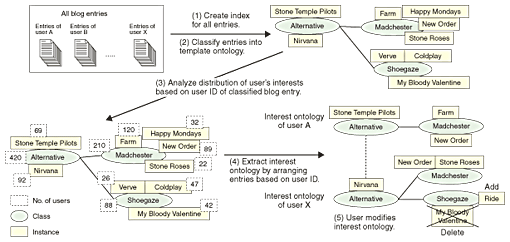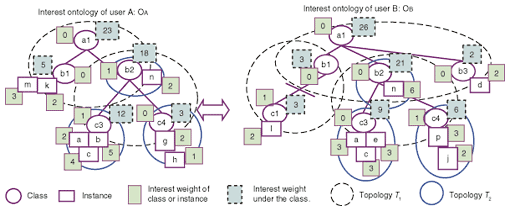 |
|||||||||||||||||||||
|
|
|||||||||||||||||||||
|
Letters Vol. 5, No. 8, pp. 21–27, Aug. 2007. https://doi.org/10.53829/ntr200708le1 Expanding User Interests by Recommending Innovative Blog EntriesAbstractWe describe a method of extracting user interests automatically by analyzing entries in users' blogs and present a new style of recommendation based on innovation detection that provides concepts similar to those in a user's profile as well as concepts that are new to the user. We classify user blog entries into service domain ontologies and extract interest ontologies that express a user's interests semantically as a hierarchy of classes according to interest weight. We also present Semantic-Driven Collaborative Filtering, which is based on similarity measurements between ontologies considering the interest weight assigned to each class and instance. We detect innovative blog entries that include concepts that the user has not thought about in the past based on an analysis of other user's ontologies with high similarities to that of the user. By introducing class characteristics about those instances, our technique can offer more accurate recommendations than previous collaborative filtering for users with a small number of instances in their user profiles. Results obtained with an online experimental service for recommending innovative blog entries to users on an actual blog portal confirmed the effectiveness of innovation detection.
1. IntroductionConsumer-generated media (CGM) such as blogs and social networking services (SNSs) are becoming more popular for publishing and discussing shared interests among users. In some CGM services like last.fm [1], a music SNS, users disclose their interests not only actively by writing entries in their blogs but also passively through listening to music. Information-sharing systems of these types could enable users to expand their interests by browsing collected blog entries or listening histories published by other users. Online recommendations made by analyzing these published user interests are essential for service providers to increase the sales of their contents. We can automatically create user profiles about their interests from listening histories by checking how many times a user listens to the same songs. By applying collaborative filtering (CF) [2]–[4] to measure the similarity between user profiles, we can recommend several songs to users comparatively easily. However, CF is apt to recommend information resources that are the same as the concepts in the user's profile. Furthermore, there is a major problem called the sparsity problem: this occurs when there is not enough data in the user profile to measure the similarity among users. In our research [5], we define an innovation as a new concept that is likely to be interesting to the user even though it is not included in his or her user profile. We try to expand the scope of user interests significantly by recommending innovative information. In particular, we apply innovation detection to blogs (web logs) because they have become a popular publishing format and targets for searching for information that could expand user interests. To achieve this purpose, we first construct a user profile automatically as a user-interest ontology, which is a class hierarchy of user interests with interest weights. We present a method of automatically extracting an interest ontology with an interest weight assigned to each class and instance. Bloggers are apt to describe their interests about topics in several service domains freely. Thus, we use blog entries to specify user interests by introducing a template ontology, which is a domain ontology of one service. We classify user entries according to a template ontology and remove classification mistakes by using class characteristics and the continuity of descriptions about user interests using a top-down approach. We also provide a user interface to update the interest ontology using a bottom-up approach. Next, we present a method for measuring the similarity of interest ontologies considering the degree of interest agreement for each class and instance. Then, we present Semantic-Driven CF by applying our measurement of similarities between user-interest ontologies to the previous CF with Pearson correlation coefficients [2]–[4]. Thus, we detect innovative blog entries for each user by analyzing other users' ontologies that have a high degree of similarity to that of the user. We apply our techniques to help users create blog communities by browsing innovative blog entries that include information that is unknown to users and has a high probability of being interesting. We executed offline experiments based on a large number of blog entries (1,600,000 entries of 55,000 users) on an actual blog portal Doblog [6], which is one of the biggest blog portals in Japan. In December 2006, it had about 55,000 users. For these experiments, we used a music template ontology with 114 classes and 4300 instances. We confirmed that our automatic ontology extraction and innovation detection have potential for creating user-oriented blog communities that correspond to user interests. The specific contributions of this article are as follows. 1. We impose a class taxonomy of instances of user interests in user profiles. Thus, we improve the accuracy of recommendations, especially for users with a small number of instances in their user profiles, by considering the similarities between instances and user-interest ontologies. This is important because many content providers have to handle a lot of users with a small number of entries in their profiles, such as light users who have just begun to use the service. We confirmed the effectiveness of our technique by using extracted results of interest ontologies to compare Semantic-Driven CF with the previous CF. 2. The evaluation was done in two steps. The first step was an offline evaluation for extracting interest ontologies and comparing the previous CF with our Semantic-Driven CF. The second step was an online evaluation for analyzing user reactions to recommen- dations based on innovation detection. (We ran an experimental service called DoblogMusic for Doblog users from August to December 2006.) Most previous studies evaluated their recommendation techniques by using only offline experimental results. However, it is very important to analyze user reactions to recommendations to check whether the recommendation techniques are actually effective. By analyzing the change in the frequency of user accesses to innovative instances of our recommendations, we confirmed the effectiveness of our ontology extraction and innovation detection. Through an evaluation of the frequency of comments between users who got to know each other through our online recommendations, we also found that recommendations based on innovation detection facilitated the creation of new communities. 2. Interest-ontology extractionHere, we explain the algorithm for generating an interest ontology by analyzing the distribution of user interests, as shown in Fig. 1.
(1) First, we make index files for all blog entries collected through the ping server. Here, we assume that each collected blog entry has a unique user ID. (2) Second, we classify all collected blog entries into a template ontology. This is knowledge about the content taxonomy such as the hierarchy of genres of music artists; it is constructed by the designers of service providers to manage and promote their contents. For example, consider the template ontology in Fig. 1. Here, the instances are the names of musical bands (e.g., Stone Roses), while classes are the names of musical genres (e.g., Madchester, a term coined to describe the alternative music scene in Manchester, UK, in the late 1980s to early 1990s). We classify a blog entry into the instance "Happy Mondays" of class "Madchester" when the character string "Happy Mondays" is included in the body of a blog entry. However, our algorithm mistakenly classifies blog entries about agricultural farms into the instance "Farm" of class "Madchester" because the only meaning it knows for farm is the name of a British band. To filter out mistakes caused by words with multiple meanings, we make use of characteristics such as class relationships in ontologies and the durability of user interests in a blog. 1. Adjacent classes have similar characteristics. Instances of those classes also have similar characteristics. 2. User interests continue for a certain period and describe an interest lasting two or more days. (3) Then, we measure the number of users interested in each instance of Ce, which is one of the end classes in the template ontology. We calculate the number of users interested in class Ce by obtaining the number of users interested in all instances in Ce and in class Ce. Thus, the distribution of interested users in the domain can be measured by recurrently counting the number of users from Ce to the root class Cr. (4) Next, by extracting only the classification results for a certain user ID from all classification results, we can extract an interest ontology for this user ID. In Fig. 1, we can extract an interest ontology of user A when the blog entries of this user describe instances of "Stone Temple Pilots", "New Order", and "Farm". 3. Interest-weight-based similarity measurementWe now explain our similarity measurement using Fig. 2. First, we define the terminology. We denote the interest ontology of users A and B by OA and OB. We use two topologies: T1 is composed of a class and subclass relationship and T2 is composed of a class and instance relationship. Furthermore, we define common classes and common instances of both ontologies as Ci and Ii, respectively. In particular, we define a common class set that formalizes topology T1 as C(T1) and a common class set that formalizes topology T2 as C(T2). For example, in Fig. 2, C(T1) has common classes a1 and b2, and C(T2) has common classes b2, b3, and c4. We also denote the degree of interest agreement of common instance Ii as I(Ii), that of common class Ci as I(Ci), and that of common topology created by common class Ci as It(Ci).
Maedche and Staab [7] calculated the similarity between ontologies considering the degree of similarity between class topologies T1. We extend this by additionally taking the following ideas from the viewpoint of creating user-interest-based communities. 1. We evaluate the degree of interest agreement between Ci s and Ii s as a smaller value of interest weight. This idea is for filtering users who only enumerate a lot of instances in an entry and for creating a community among users who have similar or larger interest weight values from the viewpoint of each user. 2. We treat topologies T1 and T2 separately because we consider that T1 reflects the width and depth of a user's interests while T2 reflects the objects in which users are interested. 3. We achieve low computational complexity by generating the class schema of user-interest ontologies according to that of template ontologies. For ontology mapping, it is important to use a large-scale dataset of the blog community such as that used in our experiments described in Sections 4 and 5. The procedure of our method is given below. (1) We analyze classes common to OA and OB and extract common classes that belong to C(T1) and C(T2). (2) If common class Ci has common instance Ii between ontologies, we assign the smaller value of the interest weight of common instances Ii to I(Ii). For example, I(a) is 2. (3) Similarly, we assign the smaller value of the interest weight of common class Ci to I(Ci). For example, I(b1) is 3. (4) We define product sets of subclasses of Ci, which are common to a class set, as N(Ci), and we define the set union of subclasses of Ci among Ci∈C(T1) as U(Ci). For example, N(a1) = {b1, b2} and U(a1) = {b1, b2, b3}. Then, we express It(Ci) as (5) We also define an instance set of Ci in ontology OA as IA(Ci), and we define an instance set of Ci in ontology OB as IB(Ci) among Ci∈C(T2). Then, we express It(Ci) as (6) By using evaluation function f(X) corresponding to the relative degree of importance of a topology, we finally assign the similarity score between ontologies So(AB) as S(T1)+f(S(T2)). 4. Results of offline experimentHere, we present the results of offline experiments and simulation studies that show the performance of interest ontology extraction and innovative blog-entry detection. We also compared the predictions of Semantic-Driven CF and the previous CF. We evaluated the performance of our methods using the large-scale blog portal Doblog. We also used the template ontology of the music domain (Fig. 1), which was created by referring to public information on goo music [8], a web portal containing music artist genre information. Our experimental template ontology contained 114 classes as genres and 4300 artists as instances. Each class and instance could have two or more name attributes. For example, the instance "R.E.M." has the name attributes of "R.E.M." and "REM". In total, we gave 7600 name attributes to 4300 instances. To evaluate the accuracy, we defined correct answers as blog entries that have descriptions of classified classes or instances and evaluated the generated interest ontology by using precision and recall in the classified results. In this paper, precision means the proportion of correct answers in classified results and recall means that of correct answers in all blog entries. When the recall was high, extracted interest ontologies covered user interests better. However, when the precision was lower, created interest ontologies included classification mistakes, and innovation detection for the user was unreliable. Thus, it is essential to achieve high precision. In the evaluation, we applied filtering algorithms to instances consisting of only one word such as "police", because we considered a single word to have a high possibility of having several meanings. To generate index files of blog entries, we used Namazu [9]. 4.1 Measuring the performance of the extracted interest ontologyWe evaluated the accuracy of our interest-ontology extraction technique by checking one quarter of the classified blog entries selected at random. As listed in Table 1, the achieved precision was higher than 90% with a high recall of 80%. Thus, our filtering algorithm is effective for generating suitable user-interest ontologies.
4.2 Comparison of Semantic-Driven CF and the previous CFWe compared the recommendation results provided by Semantic-Driven CF with the interest-ontology measurement and the previous CF with the Pearson correlation coefficient. In the evaluation, we used the dataset based on the extraction results of user-interest ontologies in Section 2: 54,933 items of interest ontologies with interest weights of 3632 users. To evaluate the performance of the prediction results, the mean absolute error (MAE) has been used in several studies on recommendation systems [2]. MAE is expressed by In the evaluation, we divided the dataset DATA into two datasets: DATA(test) and DATA(predict). We used DATA(test) in calculating the predicted values of DATA(predict). We prepared five types of DATA(test) with different ratios of DATA(test) to DATA: 16.6%, 33.3%, 50.0%, 66.6%, and 83.3%. A graph of the performance of MAE is shown in Fig. 3. Our technique achieved better results than CF when the ratio of DATA(test) to DATA was small, but worse ones when it was larger. We then divided the 3632 users into two user groups: user group UA composed of users interested in many different artists and user group UB composed of users who do not belong to user group UA. We calculated the number of users in these two groups to satisfy Άιi∈UA N(i) = Άιj∈UB N(j), (1) where the number of artists for user i is N(i). As a result, we obtained UA = 680 and UB = 2952. UB was much larger than UA. Graphs of the MAE performance of user group UB are shown in Fig. 3. For UB, Semantic-Driven CF outperformed the previous CF regardless of the value of DATA(test)/DATA. This is because Semantic-Driven CF introduces a class taxonomy about instances in user profiles for classifying those instances, especially for users with few entries in their profiles. On the other hand, the previous CF was better than Semantic-Driven CF for UA. We think that Semantic-Driven CF predicts a wider range of instances than the previous CF by using not only similarities between instances but also the class taxonomy of these instances. Thus, the predictions of Semantic-Driven CF for UA were worse than those of the previous CF because they offered more ambiguous results. However, we think that these ambiguous characteristics derived from the class taxonomy create the potential for detecting innovation for the user.
According to these results, our technique is effective, especially for users with few entries in their profiles. We think that these results are good considering that UB is much larger than UA in typical service systems. However, the purpose of our research is to predict and expand user interests by recommending innovative instances. In the next section, we evaluate innovation detection through an online experimental service. 5. ConclusionWe presented Semantic-Driven CF for expanding user interests significantly by measuring the similarity between user-interest ontologies. By using class characteristics of instances in a user profile, we can detect information that is innovative for users and improve the recommendation results, especially for users with few entries in their profiles. Comparing the effectiveness of Semantic-Driven CF with the previous CF, we found that Semantic-Driven CF achieved good prediction performance for users with few entries in their profiles. Through an online evaluation, we confirmed the effectiveness of innovation detection by checking the access frequency of users that clicked on innovative artists. Further work is required to study how users control their interest ontologies by providing feedback about their collective knowledge to update class hierarchies of template ontologies constructed by expert designers of ontologies. In addition, we need to evaluate our techniques by comparing them with template ontologies of other domains such as those of fashion or movies. References
|
|||||||||||||||||||||













